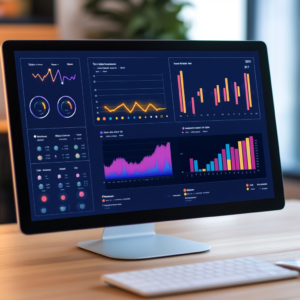1. Introduction
In today’s highly competitive digital education landscape, every decision you make must be backed by reliable data. In my experience as an educator and digital learning strategist, I have learned that understanding and tracking the right metrics is key to building a successful eLearning platform. This article, titled 7 Key Metrics Every eLearning Platform Should Track, provides a comprehensive guide on the essential metrics that can help you monitor, analyze, and optimize your online courses. Our focus keyword, 7 Key Metrics Every, encapsulates the core of what this guide aims to deliver: actionable insights into performance, learner engagement, and overall effectiveness of your eLearning programs. Throughout this article, I will walk you through the importance of data-driven decision making in online education, detail the seven most critical metrics to monitor, and share practical strategies for integrating analytics into your learning management systems (LMS). If you want to learn more about data-driven strategies in education, click here to read Boosting Student Performance with Adaptive Learning Technologies.

2. The Importance of Data-Driven Decision Making in eLearning
Data analytics has become an indispensable part of modern education. It allows us to transform raw data into actionable insights, enabling continuous improvement in the learning process. When you track the right metrics, you can pinpoint what’s working and what isn’t, personalize the learning experience, and ultimately improve student outcomes. Data-driven decision making helps create a feedback loop where educators can adapt courses in real time, ensuring that the educational content remains relevant, engaging, and effective. By harnessing these insights, you can make informed adjustments that boost learner performance and satisfaction.
3. Key Metrics Overview
In this section, I outline the seven key metrics every eLearning platform should track. These metrics cover a broad spectrum of performance indicators—from user engagement and completion rates to revenue and return on investment (ROI).
3.1 Engagement Metrics
Engagement metrics are the lifeblood of an eLearning platform. They measure how actively learners interact with your content and include:
- Session Duration: The average time users spend on the platform during each visit. Longer sessions often indicate higher engagement.
- Page Views and Click-Through Rates (CTR): These metrics reveal how often learners navigate through different sections of your course.
- Interaction Rates: This includes actions such as forum posts, comments, likes, and shares. High interaction rates signal an active, thriving community.
- Time on Task: The amount of time students spend on specific activities or modules, helping identify which parts of the course are most engaging.
Monitoring these engagement metrics provides insights into learner behavior and helps you refine course content to keep students interested.
3.2 Course Completion Rates
Completion rates are a direct measure of course effectiveness. They indicate what percentage of enrolled learners finish the course.
- Overall Completion Rate: The total number of students who complete the course compared to those who enrolled.
- Module-Specific Completion Rates: Tracking completion rates for individual modules can help you identify where learners drop off.
- Dropout and Abandonment Rates: Understanding when and why learners leave the course can provide clues to improve content or user experience.
By analyzing these metrics, you can pinpoint areas where students struggle and develop strategies to reduce dropout rates.
3.3 Assessment Performance
Assessment performance metrics reveal how well students are grasping the course material. They include:
- Quiz and Test Scores: Average scores can indicate overall comprehension.
- Assessment Completion Rates: The percentage of learners who complete quizzes or tests.
- Performance Trends: Monitoring improvements or declines over time helps evaluate the effectiveness of instructional methods.
These metrics are essential for ensuring that your course is not only engaging but also effective in delivering knowledge.
3.4 Learner Satisfaction Scores
Measuring learner satisfaction provides qualitative insights into the student experience.
- Survey Results and Feedback: Regularly administered surveys can capture learners’ opinions on course quality, content clarity, and overall satisfaction.
- Net Promoter Score (NPS): This metric indicates the likelihood of learners recommending the course to others.
- Testimonials and Reviews: Positive testimonials are a strong indicator of success and credibility.
High satisfaction scores correlate with improved retention and positive word-of-mouth, boosting your platform’s reputation.
3.5 Retention and Churn Rates
Retention rates show the percentage of students who continue with the course over time, while churn rates indicate how many drop out.
- Monthly Retention Rates: The proportion of students who return to the platform each month.
- Churn Rate: The percentage of students who discontinue the course before completion.
Monitoring these metrics helps identify patterns in learner behavior and informs strategies to keep students engaged throughout the course.
3.6 Conversion Rates and Enrollment Metrics
Conversion metrics track how effectively your platform turns visitors into enrolled students.
- Landing Page Conversion Rate: The percentage of visitors who sign up after visiting a course landing page.
- Enrollment Rate: The ratio of enrolled students to those who show initial interest.
- Cost per Acquisition (CPA): Measures the cost-effectiveness of your marketing efforts in driving enrollments.
High conversion rates are a sign of a well-optimized platform and effective marketing strategies.
3.7 Revenue and ROI Metrics
Finally, financial metrics are crucial for evaluating the overall success of your eLearning platform.
- Revenue per Student: The average income generated per enrolled learner.
- Return on Investment (ROI): The financial return relative to the investment in course development and marketing.
- Lifetime Value (LTV) of a Student: Projects the total revenue a student is expected to generate over their relationship with your platform.
These metrics help you assess the economic viability of your eLearning initiatives and guide future investment decisions.
4. How to Implement and Track These Metrics
4.1 Setting Up an Analytics Framework
Implementing data analytics requires a well-defined framework. Begin by establishing the key performance indicators (KPIs) mentioned above. Use tools such as Google Analytics, specialized eLearning analytics software, or even built-in LMS reporting features to collect and analyze data. A clear framework not only helps in tracking these metrics but also ensures that you have a structured approach to data-driven decision making.
4.2 Integrating Analytics with Your LMS
For seamless data collection, it is essential to integrate your analytics tools with your Learning Management System (LMS). Modern LMS platforms often come with built-in analytics modules that automatically track user behavior, course completion, and engagement metrics. This integration enables educators to access real-time data and make immediate adjustments to the course content and structure. By aligning your LMS with advanced analytics tools, you can ensure that every aspect of the learning experience is monitored and optimized for success.
4.3 Training Educators to Interpret Data
Data analytics is only as effective as the insights drawn from it. Educators must be trained to interpret the data and translate it into actionable strategies. Offer professional development workshops, webinars, and hands-on training sessions that focus on data literacy. When instructors understand how to use data to improve course outcomes, they can make informed decisions that drive student success. This empowerment of educators is crucial for 7 Key Metrics Every eLearning platform should track.
5. Practical Strategies to Optimize eLearning Outcomes Using Metrics
5.1 Personalizing Learning Experiences
One of the most significant advantages of tracking metrics is the ability to personalize learning. Use data from engagement and assessment metrics to tailor course content to individual learner needs. Adaptive learning technologies can adjust the difficulty level and pace of lessons based on performance data, ensuring that each student receives a customized learning experience. Personalization not only improves comprehension but also boosts motivation and retention.
5.2 Enhancing Engagement Through Interactive Content
Data analytics can reveal which types of content resonate most with your audience. Use these insights to incorporate more interactive elements such as quizzes, discussion forums, and multimedia presentations. For instance, if you notice high engagement on video content, consider expanding this format. Consistently updating and optimizing your content based on data feedback creates a dynamic learning environment that fosters continuous engagement.
5.3 Optimizing Course Structure and Navigation
Metrics related to user behavior, such as time on page and navigation paths, can help you identify bottlenecks in your course structure. Streamline the course layout to make it more intuitive and user-friendly. Redesign complex sections and ensure that learners can easily find the information they need. A well-structured course that is continuously refined based on analytics will improve the overall learning experience and drive higher course completion rates.
5.4 Leveraging Conversion Metrics to Improve Enrollment
Conversion rates are a critical indicator of your platform’s effectiveness in turning visitors into students. Use A/B testing on landing pages, CTAs, and enrollment forms to determine what drives conversions. By optimizing these elements, you can increase your enrollment numbers and reduce the cost per acquisition. High conversion rates not only indicate a well-optimized marketing funnel but also contribute directly to the financial sustainability of your eLearning platform.
5.5 Maximizing ROI with Data-Driven Marketing
Financial metrics such as revenue per student, ROI, and lifetime value (LTV) are essential for evaluating the success of your educational offerings. Use these metrics to assess the impact of your marketing strategies and course development investments. Data-driven marketing ensures that you allocate resources efficiently and continually refine your strategies to maximize returns.
For additional insights into effective marketing strategies for online courses, click here to read “Effective Marketing Strategies for Your Online Course”.

6. Case Studies and Success Stories
Real-world examples provide compelling evidence of the benefits of tracking key metrics in eLearning. For instance, one university implemented a robust analytics framework that led to a 30% increase in course completion rates and significantly higher student satisfaction. Another online learning platform used detailed engagement metrics to optimize its content delivery, resulting in a 25% improvement in quiz scores and overall academic performance. These case studies demonstrate that by embracing the strategy of 7 Key Metrics Every eLearning platform should track, institutions can achieve measurable improvements in both learning outcomes and financial performance.
7. Future Trends in eLearning Analytics
7.1 AI and Machine Learning Integration
The integration of artificial intelligence (AI) and machine learning is revolutionizing data analytics in eLearning. AI-driven tools can analyze vast amounts of data in real time, predict learner behavior, and automatically adjust content to meet individual needs. As these technologies advance, they will become indispensable for providing personalized, data-driven learning experiences that drive higher engagement and success.
7.2 Predictive Analytics for Student Success
Predictive analytics uses historical data and statistical algorithms to forecast future student performance and identify potential challenges before they become critical issues. By leveraging predictive models, educators can intervene proactively, offering tailored support to at-risk learners and ultimately improving overall outcomes. This forward-thinking approach ensures that the eLearning platform remains one step ahead, continuously adapting to the evolving needs of its students.
7.3 Big Data and Real-Time Analytics
The increasing volume of data generated by eLearning platforms necessitates the use of big data technologies. Advanced data processing tools allow institutions to analyze detailed learner behavior patterns and engagement trends in real time. This continuous stream of insights facilitates rapid adjustments to course content, teaching methods, and marketing strategies, ensuring that your platform remains dynamic and responsive.
7.4 Global Data Strategies and Scalability
As eLearning continues to grow globally, scalable data strategies become crucial. Effective data management systems ensure that metrics remain accurate and actionable, even as the number of learners and courses increases. Global data strategies enable institutions to benchmark performance across different regions and adapt courses to meet diverse cultural and academic needs, reinforcing the idea that analytics is a universal tool for success.
7.5 Continuous Improvement and Iteration
One of the key advantages of a data-driven approach is the ability to continuously refine your educational offerings. Through regular analysis, A/B testing, and iterative improvements, you can ensure that your courses evolve based on actual learner feedback and performance data. This culture of continuous improvement is essential for maintaining a high-quality learning experience over time.
7.6 Recommended Resource for Future Trends
For a deeper understanding of emerging trends and practical applications of data analytics in education, click here to watch this YouTube video on the future of online course tools. The video offers expert insights and real-world examples that complement the strategies discussed in this guide, providing a clear perspective on the future direction of digital education.

Call to Action
To further boost your online teaching career, explore our exclusive product, the study planner, organize your time and create study strategies with My Planner. Additionally, join our vibrant community by subscribing to our newsletter. Receive expert tips, updates on emerging trends, and exclusive offers directly in your inbox to help you create personalized, high-impact eLearning experiences. Sign up now and take your digital classroom to the next level.
8. Conclusion
Using data analytics to improve eLearning outcomes is not merely a technical necessity—it is a transformative strategy that empowers educators to create personalized, engaging, and efficient learning experiences. By tracking the 7 Key Metrics Every eLearning platform should monitor, you gain critical insights into learner behavior, course effectiveness, and overall performance. These metrics enable continuous improvement, help tailor the learning experience to individual needs, and ultimately drive higher academic success and return on investment.
As you implement these data-driven strategies, remember that every data point represents an opportunity to enhance the learning journey. Continuous monitoring, iterative adjustments, and the integration of advanced analytics tools will ensure that your eLearning platform remains responsive and effective in a rapidly evolving digital environment. Embrace the power of data, and let it guide you in creating an educational platform that not only meets but exceeds learner expectations.
Before concluding, reflect on how the strategic use of data analytics can transform your teaching methods and revolutionize the educational experience. With a commitment to continuous improvement and a focus on measurable outcomes, you can build an eLearning platform that is both dynamic and successful.
9. Frequently Asked Questions (FAQ)
Q1: What are the key metrics to track in eLearning?
A1: Key metrics include engagement, course completion rates, assessment performance, learner satisfaction, retention, churn rates, conversion rates, and revenue/ROI metrics—integral parts of 7 Key Metrics Every system.
Q2: How does data analytics improve eLearning outcomes?
A2: By providing real-time insights into learner behavior, data analytics allows educators to personalize content, identify areas for improvement, and optimize course structure and engagement strategies—principles at the heart of 7 Key Metrics Every platform.
Q3: What tools are commonly used for eLearning analytics?
A3: Tools such as Google Analytics, Tableau, and specialized LMS platforms help collect and analyze data, forming an essential part of the overall system.
Q4: How can predictive analytics be applied in eLearning?
A4: Predictive analytics uses historical data to forecast learner performance and identify potential challenges, enabling proactive interventions central to 7 Key Metrics Every platform.
Q5: Why is continuous improvement important in eLearning?
A5: Continuous improvement ensures that courses remain engaging and effective, with adjustments based on data and learner feedback tracked by 7 Key Metrics Every system.
Thank you for reading this comprehensive guide on 7 Key Metrics Every eLearning Platform Should Track. I hope the insights, strategies, and practical tips provided here empower you to harness the power of data analytics and transform your eLearning environment into a highly personalized and effective learning platform. If you have any questions or need further adjustments, please let me know!
